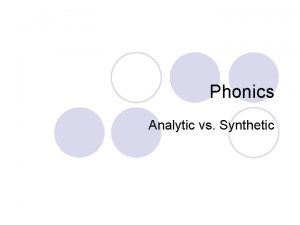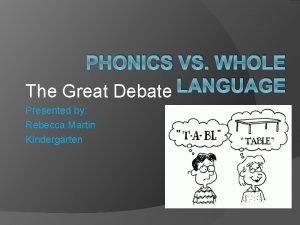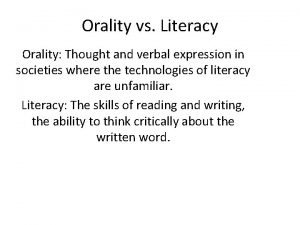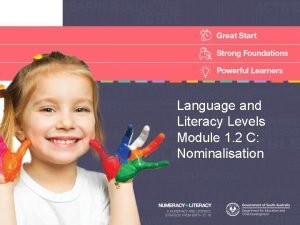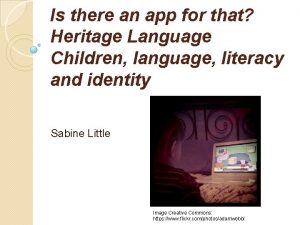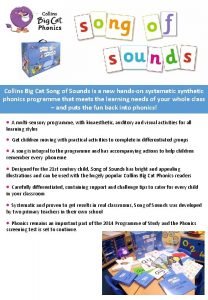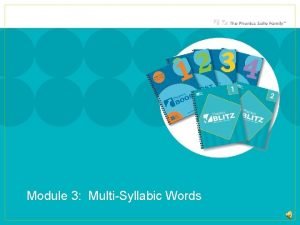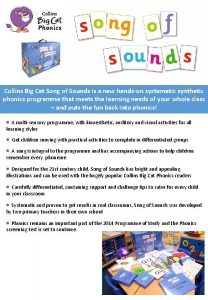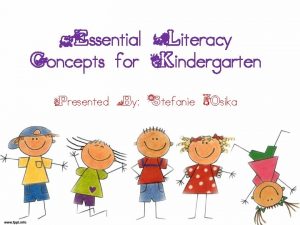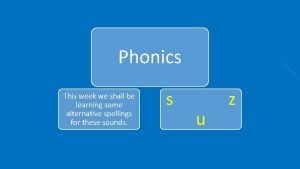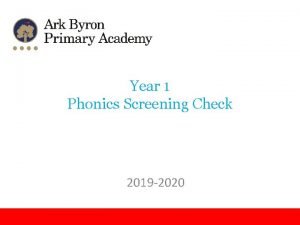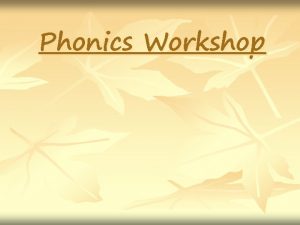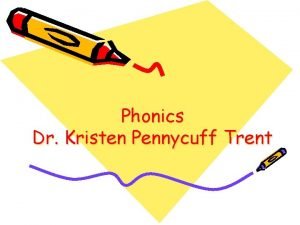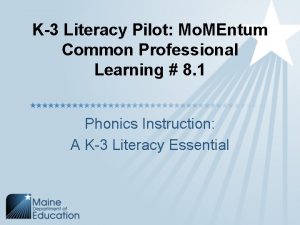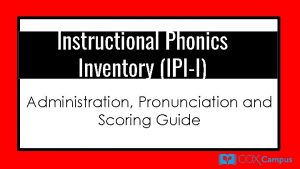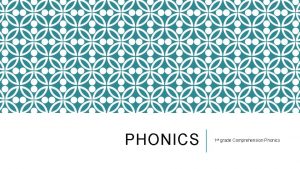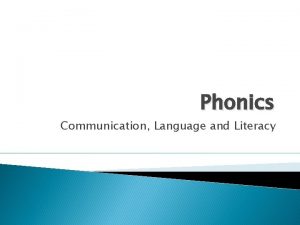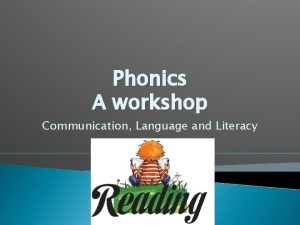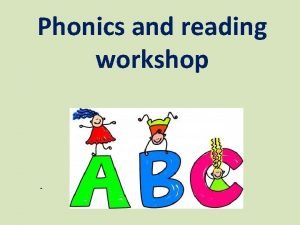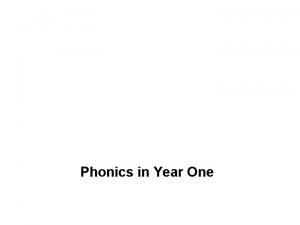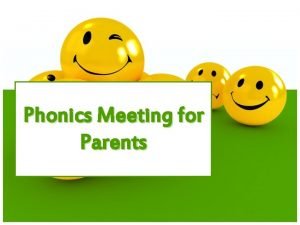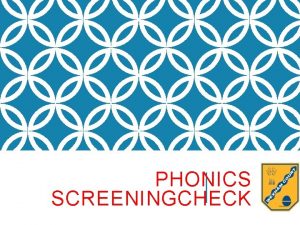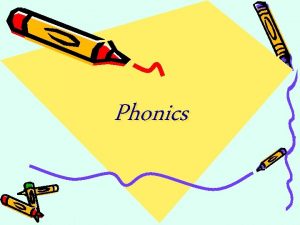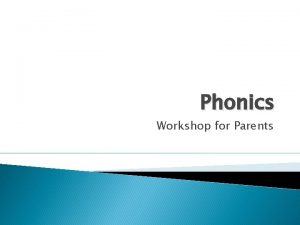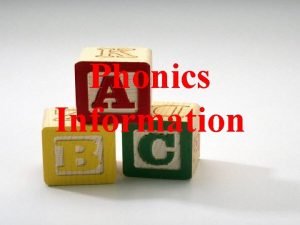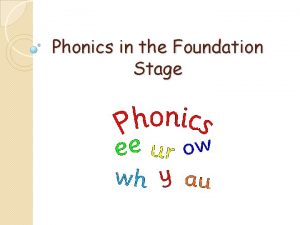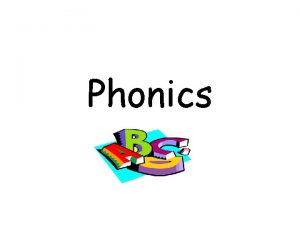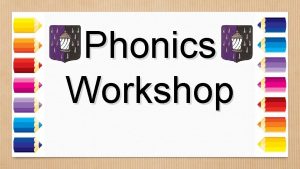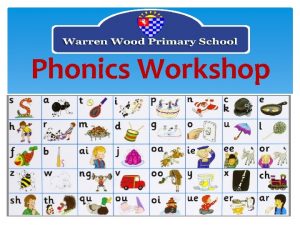Phonics Communication Language and Literacy Phonics is 1






















- Slides: 22

Phonics Communication, Language and Literacy

Phonics is 1 way of decoding words to help with reading. Other methods include: ◦ Sight recognition ◦ Reading for meaning Phonics helps when decoding unfamiliar words and spelling, especially in early writing confidence.

Phonics is. . . Knowledge of the alphabetic code Skills of segmentation and blending

Phoneme – smallest unit of sound in a word. Grapheme – a letter or sequence of letters that represents a phoneme.

Pronouncing Phonemes when Blending Cuh – ha – tuh = cat? or cuhhatuh?

Pronouncing Phonemes 1. f l m n r s sh v th z (continuous phonemes) 2. e p t ch h (unvoiced) 3. b d g w qu y j (voiced) http: //www. youtube. com/watch? v=5 J 2 Ddf_0 Om 8 http: //www. youtube. com/watch? v=Bqh. XUW_v-1 s Videos showing pronunciation of sounds

Key Principles • Sounds/phonemes are represented by letters • A phoneme can be represented by one or more letters e. g. Sh, th, ee, etc • The same phoneme can be represented/ spelled in more than one way e. g. rain, may, lake • The same spelling may represent more than one sound e. g. mean, deaf

Phase 1 • Environmental sounds • Instrumental sounds • Body percussion • Rhythm and Rhyme • Alliteration • Voice sounds • Oral blending and segmenting

Phase 2 Sounds are introduced in sets v Set v Set 1: 2: 3: 4: 5: satp inmd gock ck e u r h b f ff l ll ss

Activity: How many words can you make? With word cards: s a t p i n m d make as many CVC & CV words as you can.

Sound buttons rain witch bright laughter

Alien Words Encourages blending Games : Buried Treasure Obb and Bob Treasure Chest

Phase 3 v Letter progression and graphemes continued v Set 6: j v w x v Set 7: y z zz qu v Set 8: ch sh th ng v Teach: ai ee igh oa oo ar or ur ow oi ear air ure er

Can you use the phoneme frame to work out how many phonemes there are in these words? pig church boy curl thorn chick down shirt p ch i ur g ch

Phase 4: Reading and writing words with adjacent consonants ccvc, cvcc Eg/ struck, frog, smell, chunk

Phase 5 Alternative graphemes to represent phonemes: ai, ou, ie, ea, oy, ir, ue, aw, wh, ph, ew, oe, au, ey, Split digraphs: a_e, e_e, i_e, o_e, u_e Alternative pronunciations: i, o, c, g, u, ow, ie, ea, er, a, y, ch, ou Alternative spellings: /ai/ /c/ /ee/ /ch/ /igh/ /f/ /oa/ /m/ /oo/(y)/oo/ /n/ /ow/ /ng/ /oi/ /r//ar/ /s//ear/ /sh//air/ /v//or/ /w//ur/ /e//er/ /i//ure/ /o//zh/ /u/

Spelling Tricky Words There are several ways of learning tricky spellings. Look, say, cover, write, check – write the letters in the air to check spellings Say it as it sounds e. g. Monday is said M- on-day Mnemonics – where the initial letter of each word gives it’s correct spelling e. g. Laugh= Laugh At Ugly Goats Hair.

Handwriting Lower-case letters with correct use of capital letters Build up muscle tone in fingers Large scale movements Letter formation

How can you help at home? Most important thing – From a very early age… Talking and Listening. Reading with and to your child Playing listening games Singing songs and rhymes Simple movement games All these things will help to build up connections in the brain, an enjoyment of language and confidence to try things out.

PHONICS Correct pronunciation Correct vocabulary We all need to use the same language at home and at school. Little and often is the key. Does not have to be formal. Link it to your child’s interests.

Play lots of sound and listening games with your child. Read as much as possible to and with your child. Encourage and praise – get them to have a ‘good guess’. Ask your child’s teacher if you want to know more.

Parent Volunteers We are always looking for new and existing parents to become more involved with the school. Many trips, events and cultural occasions would be impossible without the help of our parents. We always need readers, volunteers to help in classrooms, assistance for school trips and much more. To get involved a CRB check is required – forms can be collected tonight or from the school office.
 Analytic vs synthetic phonics
Analytic vs synthetic phonics Media literacy vs information literacy comparison
Media literacy vs information literacy comparison Arniel ping/media-and-information-literacy-communication
Arniel ping/media-and-information-literacy-communication People in media people as media
People in media people as media Cyber literacy and digital literacy
Cyber literacy and digital literacy Debate table
Debate table Orality examples
Orality examples Language and literacy levels
Language and literacy levels Language literacy
Language literacy Song of sounds
Song of sounds Phonics blitz scope and sequence
Phonics blitz scope and sequence Collins big cat phonics for letters and sounds download
Collins big cat phonics for letters and sounds download Fountas and pinnell phonics kindergarten
Fountas and pinnell phonics kindergarten Phonics play obb and bob
Phonics play obb and bob What is oral communication and written communication
What is oral communication and written communication Meaning of oral communication
Meaning of oral communication Parallel communication in 8051
Parallel communication in 8051 Opportunities brought by media and information
Opportunities brought by media and information 2019 phonics screening check
2019 phonics screening check Rose report 2006
Rose report 2006 Phonics generalization
Phonics generalization Blending lines phonics
Blending lines phonics Sike pronunciation
Sike pronunciation
